Last summer I won a 1940s - 1950s Peterborough Litelift at the WCHA auction. I was told an older gentleman began the restoration and decided it wasn’t within his skill/ability to finish it properly. I hope I do it justice. If anyone can date it more exactly I would be very appreciative (see stem photo).
Thank you to Pat Corey and Jim (Boatman53) for their input and take on the scope of the project and Tsuga8 and Pat for help loading and giving their blessing on the precariously loaded canoes. I fashioned six foot closet rods from a nearby hardware store to extend my roof racks. Needless to say I took the back roads home and thankfully without incident.
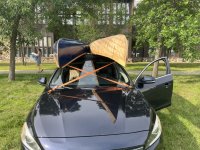
I learned my lesson from the last restoration to strip the varnish before it is too cold to use a hose. I have had good results with Total Boat paint and varnish remover and again it did a fine job. I like curved card scrapers for the planking and a carbide scraper for the ribs.
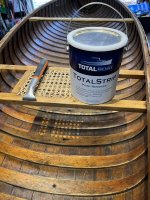
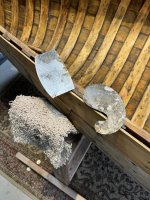
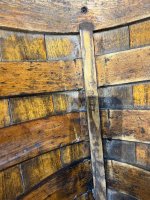
After washing with TSB there were a lot of black marks. Most of them came off with Total Boat two part Teak cleaner.
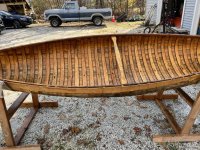
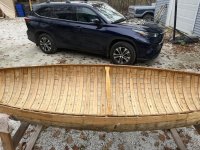
I believe I can get the rest with some light sanding. The teak cleaner did raise the grain on some ribs so it needs a light overall sanding anyway.
It is always easier to tell what needs done at this stage after it is clean and you’ve gone over every inch several times.
The good: All the ribs are in relatively good shape. A couple slight cracks that don’t seem to go all the way through which can be stabilized with backside repairs. The planking is in great shape. A couple cracked planks that I will remove and replace. The planking at the shear line was replaced nicely.
The bad: Almost all of the rib ends are rotten. I might as well do every one so they look uniform. It isn’t a difficult job, just tedious. There will be 80 of them . I could have gotten away with scarfing new inwale ends, but it will be easier to have all the rib ends exposed. I have a long piece of Norway Spruce for new inwales. The decks will have to be replaced, as they are currently what look like doug fir from a 2x6.
. I could have gotten away with scarfing new inwale ends, but it will be easier to have all the rib ends exposed. I have a long piece of Norway Spruce for new inwales. The decks will have to be replaced, as they are currently what look like doug fir from a 2x6.
I plan to make this a lightweight solo tripping boat. A centralized seat and Dacron rather than canvas. It is about 14’8”s long and currently 34”s wide. I am going to attempt to squeeze it a bit narrower during reassembly.
There is currently another project in the boat shed at the moment so this will have to wait a bit in its current state. I have a couple weeks off around the holidays and I am looking forward to the woodworking part.
Bob
Thank you to Pat Corey and Jim (Boatman53) for their input and take on the scope of the project and Tsuga8 and Pat for help loading and giving their blessing on the precariously loaded canoes. I fashioned six foot closet rods from a nearby hardware store to extend my roof racks. Needless to say I took the back roads home and thankfully without incident.

I learned my lesson from the last restoration to strip the varnish before it is too cold to use a hose. I have had good results with Total Boat paint and varnish remover and again it did a fine job. I like curved card scrapers for the planking and a carbide scraper for the ribs.



After washing with TSB there were a lot of black marks. Most of them came off with Total Boat two part Teak cleaner.


I believe I can get the rest with some light sanding. The teak cleaner did raise the grain on some ribs so it needs a light overall sanding anyway.
It is always easier to tell what needs done at this stage after it is clean and you’ve gone over every inch several times.
The good: All the ribs are in relatively good shape. A couple slight cracks that don’t seem to go all the way through which can be stabilized with backside repairs. The planking is in great shape. A couple cracked planks that I will remove and replace. The planking at the shear line was replaced nicely.
The bad: Almost all of the rib ends are rotten. I might as well do every one so they look uniform. It isn’t a difficult job, just tedious. There will be 80 of them
I plan to make this a lightweight solo tripping boat. A centralized seat and Dacron rather than canvas. It is about 14’8”s long and currently 34”s wide. I am going to attempt to squeeze it a bit narrower during reassembly.
There is currently another project in the boat shed at the moment so this will have to wait a bit in its current state. I have a couple weeks off around the holidays and I am looking forward to the woodworking part.
Bob
